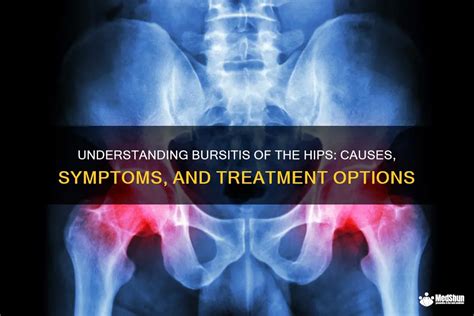Intro
Discover 5 effective ways to treat bursitis, a painful joint condition, using physical therapy, medication, and home remedies, alleviating inflammation and reducing swelling, for optimal bursitis relief and management.
Bursitis is a common condition that affects millions of people worldwide, causing pain, inflammation, and limited mobility in the affected joints. The condition occurs when the bursae, small fluid-filled sacs that cushion bones, tendons, and muscles, become inflamed or irritated. This can be caused by a variety of factors, including repetitive motion, direct blows to the joint, or underlying medical conditions such as arthritis. If left untreated, bursitis can lead to chronic pain, reduced mobility, and decreased quality of life. Therefore, it is essential to understand the available treatment options and take proactive steps to manage the condition.
Bursitis can affect anyone, regardless of age or occupation. However, certain individuals are more prone to developing the condition, such as athletes, manual laborers, or people who engage in repetitive activities. The symptoms of bursitis can vary depending on the affected joint, but common signs include pain, swelling, redness, and limited mobility. In some cases, the condition may also cause fever, fatigue, or stiffness in the affected area. Seeking medical attention is crucial to receive an accurate diagnosis and develop an effective treatment plan.
The good news is that bursitis is a treatable condition, and various options are available to manage the symptoms and promote healing. From conservative treatments to surgical interventions, the goal of treatment is to reduce inflammation, alleviate pain, and restore joint mobility. In this article, we will explore the different ways to treat bursitis, including self-care measures, medical treatments, and alternative therapies. By understanding the available options and working with a healthcare professional, individuals can take control of their condition and improve their overall quality of life.
Understanding Bursitis Treatment Options

Treatment for bursitis typically involves a combination of self-care measures, medical treatments, and alternative therapies. The primary goal of treatment is to reduce inflammation, alleviate pain, and promote healing. In some cases, surgery may be necessary to remove the inflamed bursa or repair damaged tissues. However, this is usually reserved for severe cases where conservative treatments have failed.
Self-Care Measures for Bursitis
Self-care measures play a crucial role in managing bursitis symptoms and promoting healing. Some effective self-care strategies include: * Applying ice or heat to the affected area to reduce pain and inflammation * Resting the affected joint to avoid further irritation * Using compression bandages or wraps to reduce swelling * Elevating the affected limb to improve blood flow and reduce inflammation * Engaging in gentle exercises to maintain joint mobility and strengthMedical Treatments for Bursitis

Medical treatments for bursitis typically involve anti-inflammatory medications, antibiotics, or corticosteroid injections. These treatments aim to reduce inflammation, alleviate pain, and promote healing. In some cases, doctors may also recommend physical therapy to improve joint mobility and strength.
Corticosteroid Injections for Bursitis
Corticosteroid injections are a common treatment for bursitis, particularly for cases that do not respond to self-care measures or oral medications. These injections involve administering a corticosteroid medication directly into the affected bursa to reduce inflammation and alleviate pain. While corticosteroid injections can be effective, they should be used cautiously and under the guidance of a healthcare professional.Alternative Therapies for Bursitis

Alternative therapies, such as acupuncture, massage, or physical therapy, can also be effective in managing bursitis symptoms. These therapies aim to promote healing, reduce inflammation, and improve joint mobility. While alternative therapies may not be suitable for everyone, they can be a useful adjunct to conventional treatments.
Acupuncture for Bursitis
Acupuncture is a traditional Chinese medicine technique that involves inserting thin needles into specific points on the body to stimulate healing and reduce pain. Some studies suggest that acupuncture can be effective in managing bursitis symptoms, particularly when combined with other treatments.Surgical Options for Bursitis

In severe cases of bursitis, surgery may be necessary to remove the inflamed bursa or repair damaged tissues. Surgical options typically involve arthroscopy or open surgery, depending on the location and severity of the condition. While surgery can be effective, it is usually reserved for cases where conservative treatments have failed.
Arthroscopy for Bursitis
Arthroscopy is a minimally invasive surgical procedure that involves inserting a small camera and surgical instruments into the affected joint to remove the inflamed bursa or repair damaged tissues. Arthroscopy can be an effective treatment for bursitis, particularly for cases that involve significant inflammation or damage.Preventing Bursitis

Preventing bursitis is crucial to avoid the condition and its associated symptoms. Some effective prevention strategies include:
- Engaging in regular exercise to maintain joint mobility and strength
- Using proper technique when performing repetitive activities
- Wearing protective gear, such as knee pads or elbow pads, to reduce the risk of direct blows to the joint
- Maintaining a healthy weight to reduce pressure on the joints
- Avoiding repetitive activities that can cause irritation to the bursae
Lifestyle Modifications for Bursitis Prevention
Lifestyle modifications, such as maintaining a healthy diet and engaging in regular exercise, can also help prevent bursitis. A healthy diet rich in fruits, vegetables, and whole grains can provide essential nutrients to promote healing and reduce inflammation. Regular exercise can help maintain joint mobility and strength, reducing the risk of bursitis.Conclusion and Next Steps

In conclusion, bursitis is a treatable condition that requires a comprehensive approach to management. By understanding the available treatment options, including self-care measures, medical treatments, alternative therapies, and surgical options, individuals can take control of their condition and improve their overall quality of life. It is essential to work with a healthcare professional to develop an effective treatment plan and make lifestyle modifications to prevent future episodes of bursitis.
If you are experiencing symptoms of bursitis, do not hesitate to seek medical attention. With the right treatment and self-care measures, you can manage your symptoms and promote healing. Remember to stay proactive, engage in regular exercise, and maintain a healthy lifestyle to reduce the risk of bursitis and other joint-related conditions.
What are the common causes of bursitis?
+Bursitis can be caused by a variety of factors, including repetitive motion, direct blows to the joint, or underlying medical conditions such as arthritis.
What are the symptoms of bursitis?
+The symptoms of bursitis can vary depending on the affected joint, but common signs include pain, swelling, redness, and limited mobility.
How is bursitis diagnosed?
+Bursitis is typically diagnosed through a combination of physical examination, medical history, and imaging tests such as X-rays or MRI scans.
What are the treatment options for bursitis?
+Treatment options for bursitis include self-care measures, medical treatments, alternative therapies, and surgical options, depending on the severity and location of the condition.
Can bursitis be prevented?
+Yes, bursitis can be prevented by engaging in regular exercise, using proper technique when performing repetitive activities, and maintaining a healthy lifestyle.
We hope this article has provided you with valuable information on the treatment options for bursitis. If you have any further questions or concerns, please do not hesitate to reach out to us. Share this article with your friends and family to help them understand the importance of managing bursitis symptoms and promoting healing. Together, we can take control of our health and well-being, and live a life free from pain and limited mobility.
